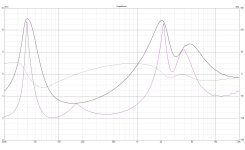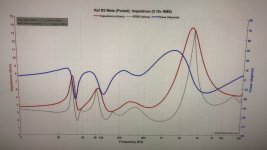I regard amplifier power dissipation as effectively an inverse of EPDR (equivalent peak dissipation resistance), i.e. peak power dissipation occurs at minimum EPDR.
A competent amp designer would ensure sufficient peak power dissipation into a real life speaker load at different frequencies.
I would expect a high quality amp to withstand momentary minima of 2 ohms. Do you have a particular amp in mind?
A competent amp designer would ensure sufficient peak power dissipation into a real life speaker load at different frequencies.
I would expect a high quality amp to withstand momentary minima of 2 ohms. Do you have a particular amp in mind?
Impedances/EPDRs like that are relatively common in speakers intended for audiophiles that typically have amplifiers capable of driving low impedance loads. If you intend to use something like a home theater receiver that's only rated to 6 or 8 ohms, it's less advisable.
Just a few from the first page of Stereophile's floor standing speaker reviews:
https://www.stereophile.com/content/dynaudio-contour-30i-loudspeaker-measurements
"the effective resistance, or EPDR (footnote 1), drops below 3 ohms from 72Hz to 1100Hz and above 13.8kHz. The minimum EPDR values are 1.73 ohms at 107Hz and 2.3 ohms at 443Hz. The Contour 30i is a relatively demanding load for the partnering amplifier."
https://www.stereophile.com/content/svs-ultra-evolution-pinnacle-loudspeaker-measurements
"effective resistance, or EPDR, drops below 3 ohms from 53Hz to 215Hz and below 2 ohms from 56Hz to 93Hz. The minimum EPDR values are 1.48 ohms at 29Hz and 1 ohm at 72Hz. As music can have high energy at the latter frequency, the Ultra Evolution Pinnacle needs to be partnered with an amplifier that doesn't have a problem delivering current into low impedances."
https://www.stereophile.com/content/bowers-wilkins-801-d4-signature-loudspeaker-measurements
"EPDR (footnote 1), or effective impedance, lies below 2 ohms between 52Hz and 107Hz and below 3 ohms between 310Hz and 418Hz, between 60Hz and 1750Hz, and above 5.5kHz. The minimum EPDR values are 1.24 ohms at 72Hz, 2.3 ohms at 362Hz, 1.62 ohms at 912Hz, and 1.82 ohms at 10.6kHz. The 801 D4 Signature has one of the most current-hungry impedances I have encountered, though this will be somewhat ameliorated by the above-average voltage sensitivity."
Just a few from the first page of Stereophile's floor standing speaker reviews:
https://www.stereophile.com/content/dynaudio-contour-30i-loudspeaker-measurements
"the effective resistance, or EPDR (footnote 1), drops below 3 ohms from 72Hz to 1100Hz and above 13.8kHz. The minimum EPDR values are 1.73 ohms at 107Hz and 2.3 ohms at 443Hz. The Contour 30i is a relatively demanding load for the partnering amplifier."
https://www.stereophile.com/content/svs-ultra-evolution-pinnacle-loudspeaker-measurements
"effective resistance, or EPDR, drops below 3 ohms from 53Hz to 215Hz and below 2 ohms from 56Hz to 93Hz. The minimum EPDR values are 1.48 ohms at 29Hz and 1 ohm at 72Hz. As music can have high energy at the latter frequency, the Ultra Evolution Pinnacle needs to be partnered with an amplifier that doesn't have a problem delivering current into low impedances."
https://www.stereophile.com/content/bowers-wilkins-801-d4-signature-loudspeaker-measurements
"EPDR (footnote 1), or effective impedance, lies below 2 ohms between 52Hz and 107Hz and below 3 ohms between 310Hz and 418Hz, between 60Hz and 1750Hz, and above 5.5kHz. The minimum EPDR values are 1.24 ohms at 72Hz, 2.3 ohms at 362Hz, 1.62 ohms at 912Hz, and 1.82 ohms at 10.6kHz. The 801 D4 Signature has one of the most current-hungry impedances I have encountered, though this will be somewhat ameliorated by the above-average voltage sensitivity."
i can't solve low EPDR. If i add 1 ohm in serie to woofer, the bass and group delay will be in bad form.
Resistor in serie to woofer is prohibit. But to boost EPDR, i don't know other method.
Resistor in serie to woofer is prohibit. But to boost EPDR, i don't know other method.
i can't solve low EPDR.
Unfortunately, loudspeaker designers seem to insist on making it difficult for amplifier designers!
https://www.stereophile.com/reference/707heavy/index.html
Quote: "Many speaker manufacturers ... are apparently happy to throw the output-device dissipation problem over the fence for amplifier designers to deal with. Jim Lesurf ... jokingly postulated the existence of SCAMP - the Society for Cruelty to Amplifiers. If it existed, its membership would be thriving."
- Home
- Loudspeakers
- Multi-Way
- Does EPDR and Generator Load Impedance like this damage SS amp?

